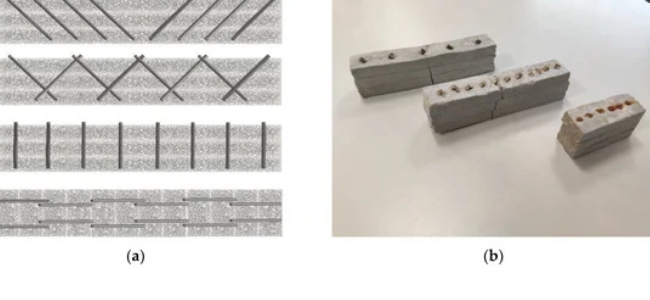Researchers from France and the UK seek ways to improve 3D printing for construction, revealing their analysis in the recently published ‘Nailing of Layers: A Promising Way to Reinforce Concrete 3D Printing Structures.’
Concrete extrusion is a continuing source of innovation for the construction industry, lending promise to 3D printed offices, homes, and entire village concepts—as well as added potential for more affordable housing. Greater affordability, speed in production, less need for manpower, and the ability to create composites for better performance are just a few of the benefits.
“Recent research on 3D printing has almost all been focused on mix-design, rheological and process related issues. It has allowed the production of a physically-based background in order to formulate concrete with the required fresh properties, and allowed us to evaluate a time window during which it is possible to deposit a new layer of cement-based material,” stated the researchers.
“Nowadays, some technical solutions have emerged in the development of successful concrete printing, and researchers have started to work on the structural performances of reinforced and unreinforced concrete printed structures.”
Additional reinforcements are the only way for some structures, including infrastructure like bridges, to adhere to standards in design. Contemporary solutions may include steel reinforcements or the use of cables, or fibers made of the following materials:
- Steel
- Basalt
- Glass
- Bio-based materials
- Polymeric fibers
In this study, the scientists experimented with the use of nails, driven through several layers after they were 3D printed. The overall goal was to offer ductility, tensile, and shear strength—while also offering greater strength in between layers.
“This strategy can be easily automated using a robotic placement of the nail which can be a real advantage and beneficial in the context of digital construction,” stated the researchers.
Placement of nails was studied regarding gradient of mechanical properties, along with evaluating reinforcement effects through three-point flexural tests examining orientation, surface roughness, and steel density.
Three-layer samples and ten-layer samples were fabricated with 10 × 25 mm² rectangular cross section layers of mortar with a screw extrusion system mounted on a WASP 3MT Industrial 4.0 printer.
Bending resistance was tested, along with post-peak behavior, and the potential for durability issues and corrosion of steel. Numerous issues must be considered to avoid corrosion, beginning with permeability, as it must be ‘the lowest possible’ to decrease carbonation and any resulting corrosion. Covers must be used to protect steel, with other materials like fly ash or granulated slag preventing steel nail corrosion. Other solutions include using stainless steel, glass, basalts, or carbon to avoid corrosion.
“It was also demonstrated that reinforcement, by using nails, was able to efficiently strengthen printed samples if the orientation of the nails was correctly chosen and the nails surface was sufficiently rough to ensure a good interface with the mortar,” said the researchers.
“In conclusion, this investigation paved a new path towards fully automated selective steel nail placements as reinforcements during the digital fabrication of concrete in order to strengthen the concrete structure.”
What do you think of this news? Let us know your thoughts; join the discussion of this and other 3D printing topics at 3DPrintBoard.com.
[Source / Images: ‘Nailing of Layers: A Promising Way to Reinforce Concrete 3D Printing Structures’]Subscribe to Our Email Newsletter
Stay up-to-date on all the latest news from the 3D printing industry and receive information and offers from third party vendors.
You May Also Like
Gorilla Sports GE’s First 3D Printed Titanium Cast
How do you help a gorilla with a broken arm? Sounds like the start of a bad joke a zookeeper might tell, but it’s an actual dilemma recently faced by...
Nylon 3D Printed Parts Made More Functional with Coatings & Colors
Parts 3D printed from polyamide (PA, Nylon) 12 using powder bed fusion (PBF) are a mainstay in the additive manufacturing (AM) industry. While post-finishing processes have improved the porosity of...
$25M to Back Sintavia’s Largest Expansion of Metal 3D Printing Capacity Since 2019
Sintavia, the digital manufacturing company specializing in mission-critical parts for strategic sectors, announced a $25 million investment to increase its production capacity, the largest expansion to its operations since 2019....
Velo3D Initiates Public Offering in a Bid to Strengthen Financial Foundations and Drive Future Growth
Velo3D (NYSE: VLD) has been among a number of publicly traded 3D printing firms that have attempted to weather the current macroeconomic climate. After posting a challenging financial report for 2023,...



































